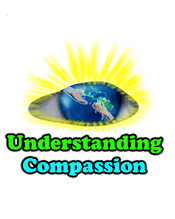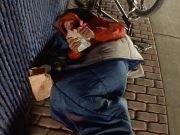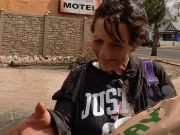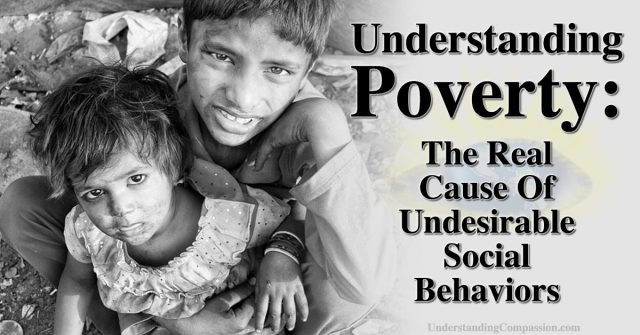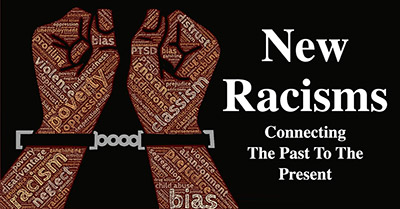Poverty is the missing link in understanding many of the ideas, stereotypes, judgments and conclusions that have been misallocated to people of color for generations. Negative social behaviors that were once inaccurately associated with ‘race,’ such as crime, violence, high birth rates, low education levels and illness, have been found to contain a common link; and it’s not skin color nor any imagined idea of ‘race.’ The actual cause and connection of many undesirable social behaviors is one that studies have proven time and time again: it’s poverty.
Poverty is the scarcity or the lack of a certain (variant) amount of material possessions or amount of money. Poverty is a multifaceted concept, which may include social, economic, and political elements. Poverty refers to the lack of the means necessary to meet basic personal needs such as food, clothing and shelter.[1]
Poverty can mean both not having enough resources to survive, and can also refer to a person living in a country or area whose standard of living falls below the minimum level of ‘living standards’ when compared to the rest of the population of that country.
Poverty means many things: It often means sleeping on the ground. Not having enough to eat. Having one or two torn, old and worn pieces of clothing to your name. Being constantly cold in the winter, sometimes even close to freezing, and being unable to cool down from the intense heat of the summer sun. It means not being able to go to the doctor, not being able to send your children to school. Poverty is having to spend any and all money as soon as it is earned, day after day, just to survive. It means watching loved ones suffer from lack of opportunity, from lack of having something to eat, from the lack of basic human needs to survive.
The following studies examine many of the negative ‘racial’ stereotypes misallocated to people of color, and show the truth related to undesirable social behaviors: that they are the result of poverty, not skin color.
1. Poverty And Crime
As Aristotle once famously wrote, “Poverty is the parent of crime,” and statistics from around the world have since confirmed the truth behind these wise words of the great philosopher. Research, data, studies and statistics have all shown that crime and poverty are directly related to one another, and it’s not hard to understand why. When someone is extremely poor, and is often on the border between living and dying due to starvation, getting food and meeting their basic needs becomes a priority of survival. As strong willed as we can try to be, the basic human need to survive becomes stronger than any law or rule created by society or by the mind, and a starving person, regardless of their skin color, will choose to eat and to survive, even if it means taking food that they cannot pay for.
Studies have shown that with an increase in poverty also comes an increase in crime and violent crime.[2] This is because people living in the poorest of conditions are desperate. With desperation comes the need to survive through any means necessary. When someone is not able to afford the basic necessities to survive, crime seems an easier alternative than going hungry and extreme suffering.
Researchers have found that those who commit and are convicted of crimes have a median annual income of 41% less than those who do not commit crimes.[2] These numbers apply regardless of any ideas of ‘race,’ skin color, gender or ethnicity, as experts at Prisonpolicy.org report;
“We found that incarcerated people in all gender, ‘race,’ and ethnicity groups earned substantially less prior to their incarceration than their non-incarcerated counterparts of similar ages.”[2]
The following graphs of data gathered by the Bureau of Justice Statistics reveals the clear connection between those living near or below the national poverty level and crime:
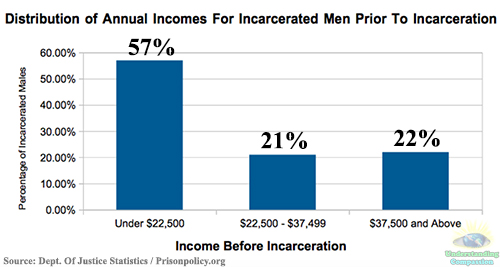
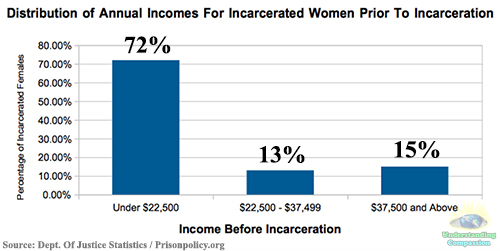
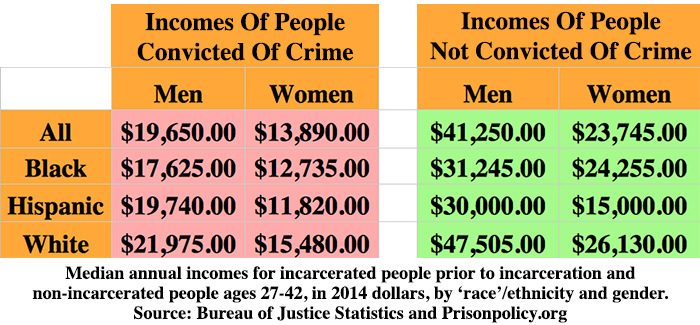
The United States Bureau of Justice Statistics also reported that:
- Persons in poor households at or below the Federal Poverty Level (39.8 per 1,000) had more than double the rate of violent victimization as persons in high-income households (16.9 per 1,000).[2]
- Persons in poor households had a higher rate of violence involving a firearm (3.5 per 1,000) compared to persons above the Federal Poverty Level (0.8–2.5 per 1,000).[2]
- Poor Hispanics (25.3 per 1,000) had lower rates of violence compared to poor blacks (43.4 per 1,000), who had lower rates of violence compared to poor whites (46.4 per 1,000).[2]
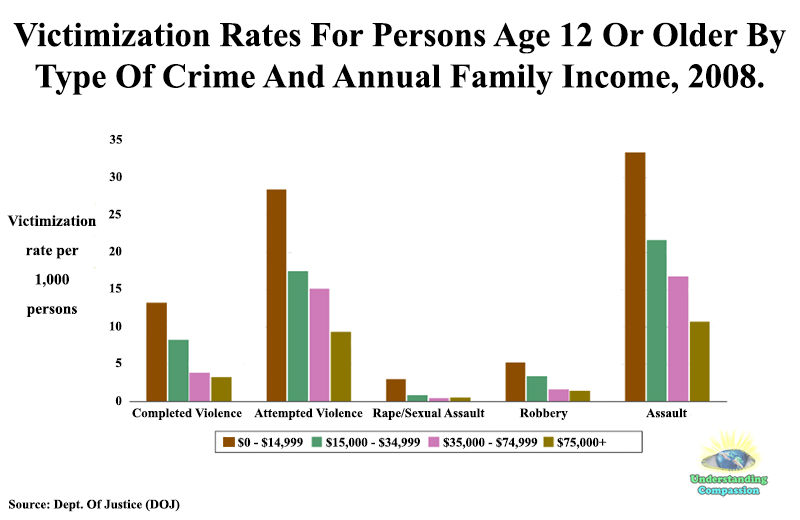
What does this data indicate? That there is a direct correlation between incomes, living in poverty and violent crime in the United States. It has shown that darker skin color does not indicate higher amounts of violence, but rather in this nationwide study which was conducted over four years and observed over 162,000 households, it found the opposite.[2]
With further research the United Nations concluded that “Poverty is the ferment for crime.”[3] It was found that there is also a higher rate of mental illness among the poor than among the rich,[4] as poverty often leads to extreme levels of stress that negatively affect the body, mind and emotions.
The Edinburgh Study of Youth Transitions and Crime found that poverty had a significant and direct effect on youth and their likelihood to engage in violence at age 15.[5] They also found that young people are more likely to participate in violent behavior when the head of the household is unemployed, and that even individuals with “low-risk” backgrounds are more likely to engage in violence when they are poor.[5] The conclusion was that living in a poor household increases the likelihood of violence among young people.[5]
Another recent report on poverty and crime studied over half a million adolescents between the ages of 15 and 21 over the course of four years and found that those who had grown up within families whose incomes were in the bottom 20% nationally were seven times more likely to be convicted of a violent crime, when compared to adolescents who grew up in the top 20% of incomes.[6]
The list goes on; there is seemingly endless data that clearly shows that poverty causes crime, and it includes people of all nationalities, ethnicities, genders and all skin colors. Many inaccurate stereotypes have existed within America and around the world for years concerning minorities, especially targeting African Americans. Examples of inaccurate stereotypes include; ‘black people like to steal’, ‘black people are more violent and sexual than white people’, and that ‘black people are prone to crime.’ Yet as we’ve seen from the actual data concerning who commits crime, it’s clear that these statements are simply inaccurate and untrue.
The reality is that poor people living in poverty are more likely to steal and to commit crime due to their circumstances; not because of black skin color, tan skin color or white skin color. Crime is a result when human beings have less than they need to survive. Skin color has nothing to do with it. Yet since the days of slavery and thereafter, African Americans have been forced into poverty, ghettos and into positions of being poor due to heavy discrimination, prejudice, lack of available resources, lack of available education and lack of opportunity.[7]
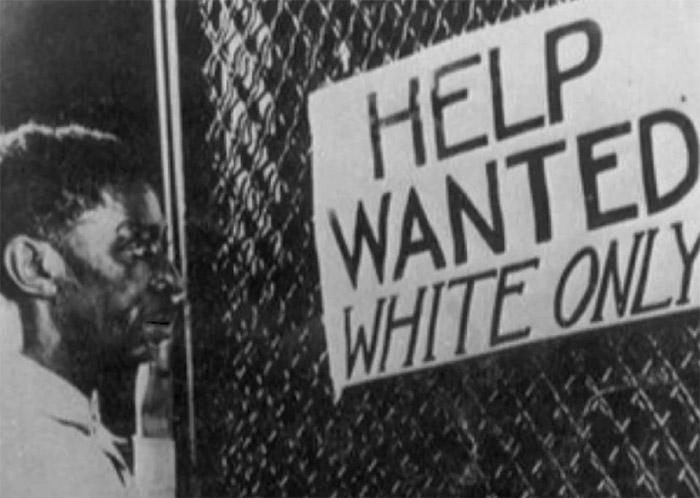
It would take hundreds, if not thousands, of pages to describe all of the unjust laws written and discriminatory circumstances that have forced people of color into poverty and into the suffering that comes with it during the past 500 years in America. Here are just a few to see:
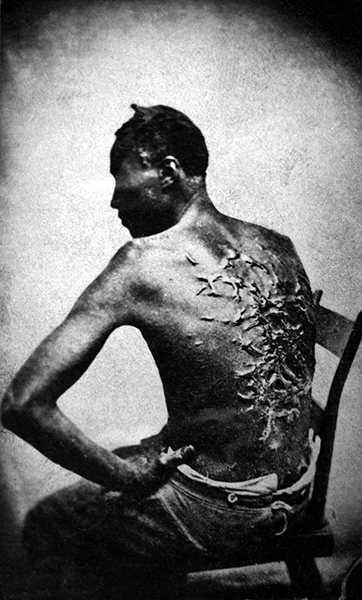
- 1619-1865: Slavery: Abuse, whipping, torture, forced rape, and killing of African-Americans was common.[8]
- 1830: Denying Basic Education: US State laws prohibit teaching slaves to read or write.[9]
- 1865-Present: Ku Klux Klan: Residents of southern states form the KKK to use terrorism, business, housing, law enforcement, legal positions, physical assault and murder against people of color.[10]

- 1619-Present: Police Brutality: Racial profiling of people of color whereby some police officers view and act on their own ‘racial’ biases believing that minorities are generally deserving of punishment.[11]
- 1865: Denying Land Ownership: Andrew Johnson, Lincoln’s successor and known confederate sympathizer, overturned a law which promised to give African Americans land to own in the south.[12]
- 1865-Present: Systemic Inequality and Denying Jobs: Employers have consistently denied employment to African-Americans, instead hiring white workers who fit certain racial criteria.[13]
- 1896: Racial Segregation: The Supreme Court ruled by a 7-1 vote a major decision in the court case Plessy vs. Ferguson by claiming that racial segregation was constitutional.[14]
- 1890-Present: Disenfranchisement: A series of laws, new constitutions, and practices were and are still currently deliberately used to prevent black citizens from registering to vote and voting.[15]
The list seemingly has no end, and continues to grow even into this present day.
To begin to understand the effect this level of discrimination has had on forcing African-Americans into poverty, we can use the analogy of corn seed: If the same corn seed is planted in two different environments, the results can be quite different. The seeds will grow in Iowa, but not in the Mojave desert, and the result will have nothing to do with the corn seed itself, but the environment in which it was grown. Both white American children and black American children have been born in and have grown up in America, but the social environment for black Americans has been more like a desert when compared to the social conditions in which whites have lived. This has resulted in black Americans being unable to succeed in an unequal system, and has caused large percentages to fall into poverty, and into the suffering that comes with it.
Many scholars have traced the stereotype of ‘African Americans as being criminals’ back to the days of slavery, where it was first constructed as a tool to “discipline” and control slaves.[16][17] As slaveowners feared that slaves would desire their freedom and stage a rebellion, these slaveholders actively sought to spread the stereotype that African Americans were dangerous criminals in order to impose strict laws and to prohibit the education of slaves, thus maintaining an even tighter control over those poor human beings.[16][17]. These ancient and untrue stereotypes still exist today, and continue to be the source of institutional racism.
For example, due to racial bias today in the American legal and prison system, African Americans are seven times more likely to be convicted of a crime by American courts than are white Americans.[18] Given similar evidence and similar testimonies for similar crimes, judges in the American legal system unjustly sentence humans with black skin seven times more often than they sentence humans with white skin. There are also large numbers of white Americans consciously and actively seeking to imprison and persecute black Americans.[19][20]
Many African Americans, once put in prison, are forced to do free labor.[21] This is what modern day slavery looks like in America today, and it has been intelligently organized and created by Americans with deeply racist agendas. The facts are that, as research has shown, skin color does not predict crime nor does it cause crime. Poverty causes crime, not skin color.
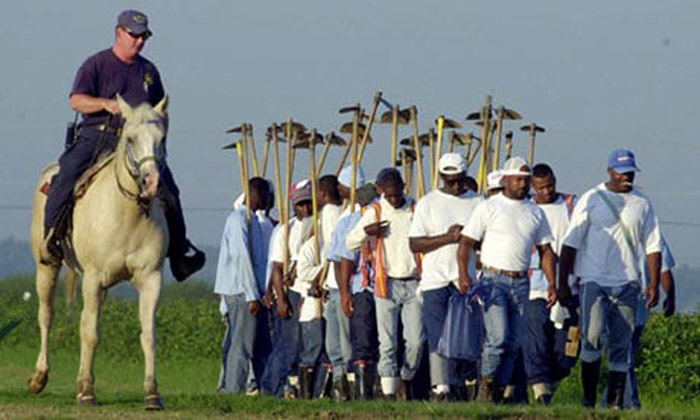

Les Miserables: A Lesson Of Poverty And Compassion
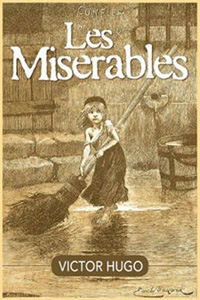
Victor Hugo’s famous classic Les Miserables[22] includes a powerful example teaching us how poverty turns well-meaning people to crime: In the 1700’s, France, Hugo’s character Jean Valjean struggles to save his widowed sister, her seven children and his own life from starvation by breaking into a bakery and stealing a loaf of bread. Upon being caught, he ends up spending 19 years in prison; suffering through horrible abuse and slave labor, all for attempting to feed his family during a time of economic depression and famine. He is, after a tragic 19 years, released, and after being subject to such horrible conditions for so long, turns to stealing again, this time from a Christian bishop who gave him shelter and food for the night.
The world famous novel deeply describes the anguish and regret he feels in doing so shortly after, and even more so when the police find him with the stolen goods. Again Valjean is captured by authorities, and this time he fears for the worst; that he will be imprisoned for the rest of his life. But when he is brought to the bishop by authorities with the stolen goods, the bishop insists that the stolen goods were a gift given by the bishop to Valjean, to give him a good start to his new, free life, and to purchase Valjean’s soul. The kind bishop told Valjean that he had forgotten to take the silver candlesticks with him, as the bishop had wanted, that he wished him well, and that he was a loved child of God. This single act of compassion changes the life of Valjean, and the rest of the novel beautifully illustrates how his heart changes as he begins to help others who are both abandoned and unfortunate.[22]
When considering how society should deal with people who turn to crime as a result of poverty, the compassionate answer is to first understand the difficult circumstances which cause people to turn to crime. We must show compassion by fixing the causes of poverty, and help to elevate the poor out of poverty before anyone turns to crime as a means to survive.
2. Poverty And High Birth Rates
Studies show that the amount of children families tend to have is highly connected to their financial status and poverty level. Poor families who live in poverty tend to have more children, while wealthier families not living in poverty tend to have less children. Research has found several reasons for this:
- Lack Of Contraception
Lack of contraception, ability to buy contraception, and education on contraception caused by being poor has those in poverty use contraception less frequently and leads to five times higher birth rates.[23][24] - Child Mortality Rates
Child mortality rates are much higher for the poor as they do not have sufficient access to medical care. This leads poorer parents to having several or more children in order to be sure that some of their children will survive and to be able to take care of them when they reach old age.[25] The World Health Organization also reported that the fear of death of a child and actual death of a child result in higher fertility rates.[26] - Low Education Levels
Studies and statistics have shown that birth rates, education levels and poverty levels are all connected. People living in poverty tend to have less opportunity for education,[27] and low education levels directly correlate with higher birth rates.[28]
Data-based theories on why education levels affect birth rates suggest that women who attain higher education have higher opportunity costs in terms of lost income, learn different ideas of ideal family size through school, and are able to voice their opinions more compared to male-dominated societies where often women remain uneducated and have no say in the timing or amount of children they have within their marriage.[29]
The following graph shows the birth rate per 1000 women in the United States according to household income:
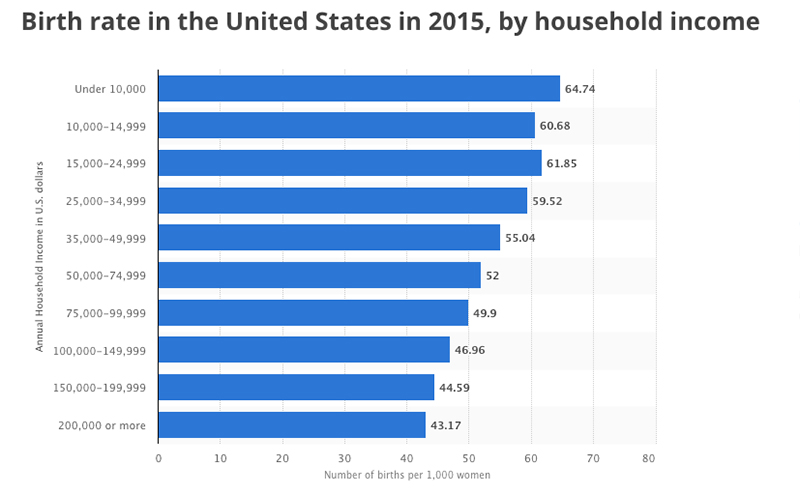
The data shows that income earners above $200,000 per year average 43.17 births per 1000 women, and that income earners below $10,000 per year average 64.74 births, a very significant difference. Research has steadily shown that regardless of skin color, perceived ‘race’ or ethnicity, that income levels and poverty levels can consistently predict the average amount of babies that are born to women within the United States.
Studies have also proven that the same is true outside of the United States and around the world. Researchers found that when families are elevated financially and no longer live in extreme poverty, they have less children.[30] Studies observing the birth rates in Guatemala, Cambodia, and Namibia; a population almost entirely consisting of humans with black skin, discovered that when poverty levels decrease, average family sizes decrease as well. The reduction of poverty for two decades in these countries has decreased birth rates by nearly 50%.[30][31][32]
When it comes to high birth rates, research has shown that the amount of children people tend to have is connected to their income and largely connected to if they are living in poverty. Whether someone has white skin, brown skin, tan skin or black skin, the real statistics related to their birth rates is tied directly to their incomes and poverty levels. The reality of statistics shows that it is not skin color that dictates the amount of children a family has. High income families tend to have less children, and low income families tend to have more children.
Many stereotypes have existed claiming that Africans, Mexicans, Asians and other American minorities have “too many babies,” and that this is somehow connected to their imagined “race” or to their non-white skin color. These ideas often come from inaccurate assumptions, misinformation and faulty conclusions being made when witnessing a large family size of a poor family, who may happen to be a minority.
It’s likely these stereotypes came into existence when individuals from higher income households, namely white individuals, saw individuals from poorer income households, namely people of non-white skin color, having higher amounts of children when compared to themselves, and often couldn’t afford to adequately take care of them. They likely incorrectly assumed that the person’s skin color or imagined ‘race’ was the reason that they had higher amounts of children, rather than understanding that it is a result of people of all skin colors who live in poverty. Research shows that when average incomes increase for people of white and non-white skin color, they have less children, and when average incomes decrease for people of white and non-white skin color, they tend to have more children. Birth rates are not connected to any imagined idea of ‘race’ or skin color, but they are connected to income levels and poverty levels.
The accurate data regarding high birth rates speaks for itself, and it’s an important subject to understand as the world moves towards maintaining a sustainable number of humans on the planet. Many minorities of non-white skin color have been forced into poverty due to centuries of ‘racial’ discrimination, and often have also come from poverty within second and third world countries. The poor are not people to be judged, criticized, or looked down upon. As many of the great compassionate teachers and moral guides of the past have taught us, the poor are those we need to help and take care of as equal and lovable human beings.
Researchers and doctors have recently discovered that stress due to encountering racism in the United States is causing African-American women to have a more than double infant mortality rate when compared to white Americans. According to the U.S. Centers for Disease Control and Prevention, for every 1000 live births, 4.8 white infants die in the first year of life, but for black babies, that number is 11.7.[33] Some suggested that it could be genetics, but if genes were the cause, then women from Africa would have the same risks. The New England Journal of Medicine compared U.S. born blacks, African born blacks and U.S. born whites and found that certain differences that affected infant health existed only for black babies being born in the U.S., and numerous other studies are concluding that stress caused by racism in America is leading to stress-induced premature births and doubling the rate of African-American infant mortalities. National Public Radio did a major story linking these studies which can be found here.
Where high birth rates and world overpopulation are concerned, the real problem is that in this day and age of advanced agriculture and technology, our society still allows human beings to fall through the cracks and to live in poverty. The only way to stabilize the growing number of people on the planet is to elevate everyone out of poverty through higher education and through having available resources. When people are educated, they elevate themselves out of poverty, and create the solutions we need as the global population reaches its maximum capacity. Education works, and is the only humane and compassionate solution to solving problems related to overpopulation.
In this 3-minute video, Dr. Martin Luther King Jr. powerfully speaks about poverty:
In this 2-minute video, Dr. Martin Luther King Jr. explains how discrimination put African Americans in poverty:
3. Poverty And Education Levels
Poverty and Education levels are inextricably linked, as higher education helps and allows individuals to elevate themselves out of poverty, while lack of education and opportunity for schooling keeps individuals in poverty. Often those living in poverty must stop going to school so that they can work just to survive, which leaves them without the higher education they need to climb out of the pit of poverty. Their children, in turn, find themselves in similar situations years later; with barely enough income to survive and with few options but to leave school and to work a low paying job; creating a vicious cycle for families living in poverty. People living in poverty who are unable to receive a public education all the way through college have a difficult to near impossible time becoming free from their poor working and living conditions.
Data shows that the higher the level of education an individual has, the less likely they are to be living in poverty, and that the lower the level of education they have, the more likely they are to be living in poverty.[34]
The following graph is data collected by the U.S. Census Bureau and is a strong indicator showing how significantly education levels impact poverty levels:
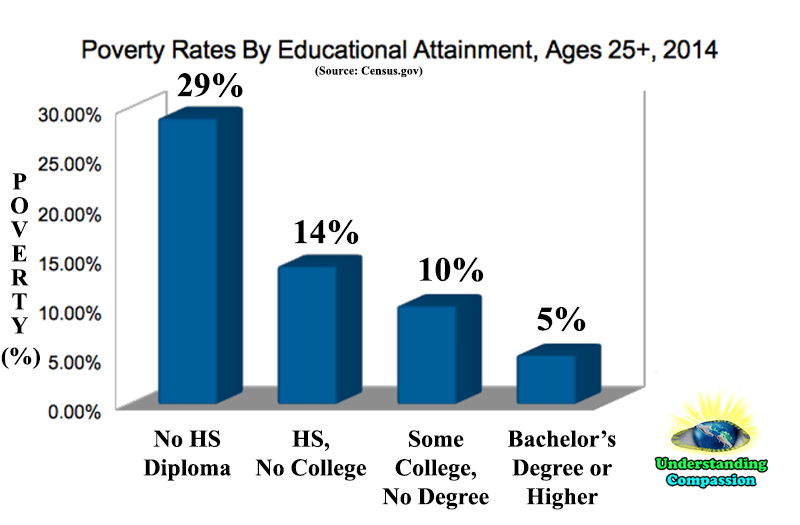
- 5% of people with a bachelor’s degree or higher live in poverty.
- 10% of people with some college but no degree live in poverty.
- 14% of people with a high school diploma and no college live in poverty.
- 29% of people with no high school diploma live in poverty.
Higher education through college allows individuals to receive the knowledge and training they need to attain higher paying jobs, which in turn can help to alleviate poverty. The data is quite clear; higher education, which is connected to higher income levels, reduces and nearly eliminates poverty.
Education levels and Birth Rates are also strongly connected, as studies have shown that the higher one’s education level is, the less amount of children they tend to have.[35] In an international study of 185 countries comparing the rates of primary school enrollment with the number of children born per woman, major connections were observed; countries with high rates of residents enrolling in school had lower amounts of children born per woman, and vice versa.
The following table shows the top five and bottom five ranked countries for primary school enrollment, and their corresponding fertility rates:
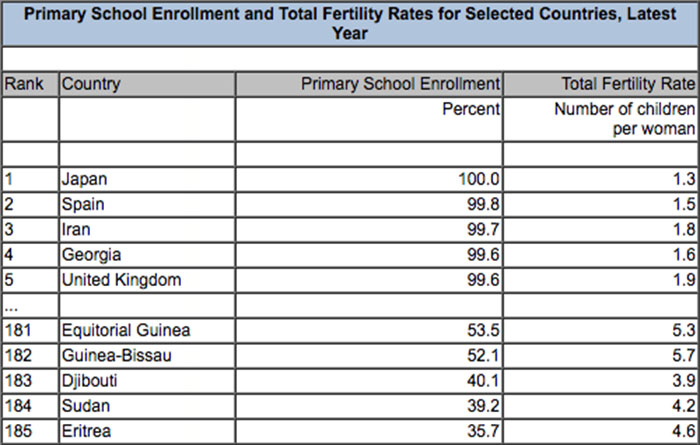
Japan, with a 100% primary school enrollment rate and ranked #1 in the world has an average 1.3 children born per woman, compared to the United States ranked #92 with 92% enrollment and an average of 2.1 children born per woman, to Eritrea ranked #185 with a 35.7% enrollment in primary school and an average of 4.6 children born per woman.[35] This worldwide data shows that education levels strongly correlate with fertility rates.
There are various reasons for this, including that; higher education expands awareness of contraception, higher education is connected to increased rights for women and gives them more of a say in choosing to have children, and that higher education can delay marriage and fertility while individuals are pursuing school.[36] Higher education also allows women to know more about prenatal care and child health, which gives them a greater confidence that their children will survive, leading to a lower need to have high numbers of children.
The economic theory of fertility suggests an incentive effect: that highly educated women have higher opportunity costs when it comes to having children in terms of lost income from time off of work, from leaving jobs and other factors. The household bargaining model suggests that highly educated women are better equipped to support themselves and have more bargaining power within their relationships, including the topic of family size. The ideation theory explains that highly educated women may learn different ideas of desired family size through school, community, and exposure to global communication networks. Whereas their parents, culture or religion may have dictated that having large amounts of children was the only acceptable route, education shows them another way; one that is more affordable and sustainable.[37]
When it comes to solving a world problem such as overpopulation, the findings from research and data strongly indicate that raising education levels, and thus eliminating poverty, are the only proven ways to balance the world’s human population. Denying people resources, denying education, refusing to help and willful ignorance towards those living in poverty; these all greatly exacerbate the problems created from poverty.
No one should have to live wondering what they will eat the next day, or where they will sleep, or if they can receive healthcare when they are sick. All humans are created equal, deserve a healthy life, deserve their own liberty, and deserve their own pursuit of happiness, and it’s important that we all work together to elevate all of humanity out of poverty.

In this 4-minute video, real, lovable people living in poverty share their stories with us:
How To Solve Poverty
As we’ve seen from the research: many of the biggest issues in society are in fact not related to, nor caused by skin color nor any imagined notion of ‘race,’ but are rather caused by poverty. Poverty is indeed the missing link in understanding many of the ideas, stereotypes, judgments and conclusions that have been misallocated to people of color for generations. Negative social behaviors that were once inaccurately associated with ‘race,’ such as crime, violence, high birth rates, low education levels and illness, contain the common link of poverty. So the core question comes then; how do we elevate people out of poverty?
Many compassionate people today around the world are looking for ways in which to help solve the issues related to poverty; to provide free schooling through college for all people, to help those who are poor and struggling get the resources and basic needs they need to survive, to provide for those who are homeless, to reduce crime and to make neighborhoods safer, to be conscious of family sizes and to protect the world from overpopulation, and to be compassionate towards the entire human ‘race.’
Ideas have been circulating that one of the solutions to negative social behavior is that children need to be “raised right” by parents in order to create a healthy and sustainable society free from crime. While devoid of any scientific studies to back this claim, these ideas are rooted in a place of a desire for a safer world. Yet the reliance on parenting alone is not enough to create a society of positive social behaviors free from crime. Elevating families out of the deep cycles of poverty does reduce crime and has been proven to do so. A parent living in poverty and struggling to provide for their family is under very high amounts of stress, and without having received a higher education themselves, often is not able to raise and parent a child the same way a middle income parent with a college education, plenty of nutrition, training in psychology, a healthy childhood and available resources can. When people are given higher education, and are elevated out of poverty, that’s when the research shows that decreases in crime, birth rates, illnesses and much more happen, all of which greatly benefit and create a loving society.
While the stereotype and argument sometimes also comes that, “Well then maybe ‘they’ shouldn’t have so many children,” it’s important to remember the data related to having high amounts of children, and it’s always important to listen to facts and actual research when formulating opinions. The worldwide data states that people who have not been able to receive a higher education are usually poorer and living in poverty, and living in poverty results in having larger families. This is the human condition, one that we must accept, and then work together in a positive and loving ways to solve. If we truly desire to help improve the world’s problems, then we must truly help to elevate everyone out of poverty.
The answer we are seeking then does not exist in judging those who are poor and are living lives that reflect their state of poverty, but the answer exists in helping to reduce poverty altogether. It exists in showing compassion to your fellow man and woman; your brother and sister. It exists in helping the poor, in providing for those in need, in offering higher education and adequate living expenses when higher education is pursued. When poverty levels decrease, crime also greatly decreases because people have what they need to survive.[38] Birth rates are also greatly reduced, as studies have proven, and disease and illness vastly decrease as people can afford medical care.[39]
Supporting free higher education for all people, higher minimum wages, and social programs that help the poor are how we can elevate people out of poverty and create a better, safer and more compassionate world for everyone in it. As humanity’s level of technology continues to advance and grow, eventually developments in energy and agriculture will help to provide resources in greater amounts than are required, and basic needs will be easily provided for all people around the globe. Until then, let’s all do the best we can in helping elevate our neighbors out of poverty and raise them out of the suffering that comes with it.
